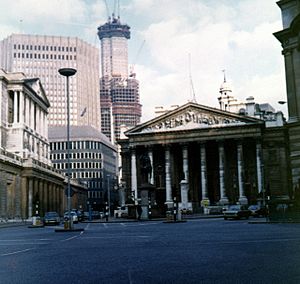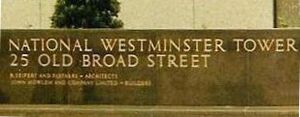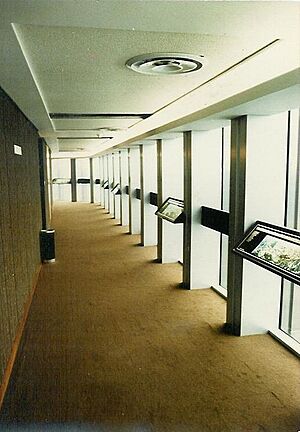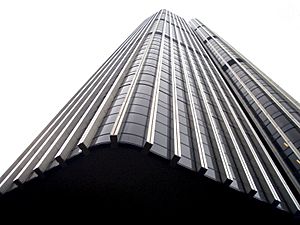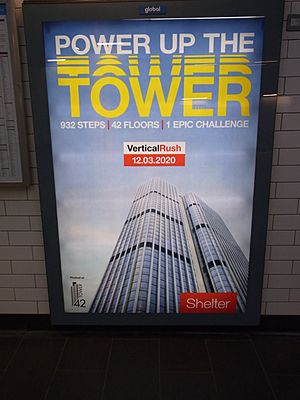Tower 42 facts for kids
Quick facts for kids Tower 42 |
|
|---|---|
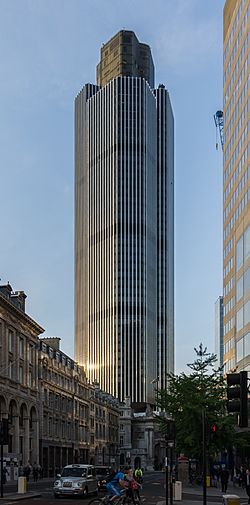
Tower 42 is the fifth-tallest building in the City of London
|
|
| Former names | NatWest Tower; International Financial Centre |
| Record height | |
| Tallest in the United Kingdom from 1980 to 1991 | |
| Preceded by | BT Tower |
| Surpassed by | One Canada Square |
| General information | |
| Type | Commercial |
| Location | London, EC2 |
| Coordinates | 51°30′55″N 0°05′02″W / 51.51528°N 0.08389°W |
| Construction started | 1971 |
| Completed | 1980 |
| Height | |
| Roof | 183 metres (600 ft) |
| Technical details | |
| Floor count | 47 |
| Floor area | 30,100 m2 (324,000 sq ft) |
| Lifts/elevators | 21 |
| Design and construction | |
| Architect | R Seifert & Partners |
| Structural engineer | Pell Frischmann |
| Main contractor | John Mowlem & Co Ltd |
Tower 42 is a very tall building, called a skyscraper, in the City of London. It stands 183 metres (600 ft) high. It's the fifth-tallest building in the City of London and the fifteenth-tallest in Greater London.
When it was first built, it was called the National Westminster Tower, or NatWest Tower for short. It was made to be the main office for the NatWest bank. If you look at the tower from above, its shape looks like the NatWest bank's old logo, which had three V-shapes (called chevrons) arranged in a hexagon.
The tower was designed by Richard Seifert and engineered by Pell Frischmann. It's located at 25 Old Broad Street. The company John Mowlem & Co built it between 1971 and 1980. People started working there in 1980, and Queen Elizabeth II officially opened it on 11 June 1981.
Building the tower cost about £72 million back then. It was the tallest building in the United Kingdom until 1990. That's when One Canada Square in Canary Wharf became taller. Tower 42 was also the tallest building in the City of London for 30 years. Then, in 2009, the Heron Tower became taller.
Today, Tower 42 has many different companies renting office space. It also has restaurants on the 24th and 42nd floors. In 2011, a businessman from South Africa named Nathan Kirsh bought the tower for £282.5 million.
Contents
History of Tower 42
How the Tower Was Built
Work to clear the site started in 1970, and the tower was finished in 1980. The builders, John Mowlem & Co, constructed the building around a huge concrete core. The floors then stick out from this core, like branches from a tree. This design makes the building very strong.
The tower has 47 floors above ground. Forty-two of these floors stick out from the core. The lowest floor that sticks out is called Level 1. The floors are shaped like three "leaves" or segments, which match the three V-shapes in the old NatWest logo.
The building had some new and clever features for its time. It had special lifts that could carry people on two levels at once. These lifts went straight to "sky lobbies" on floors 23 and 24. These sky lobbies were like mini-lobbies high up in the building. Both double-decked lifts and sky lobbies were new to the UK back then.
Other cool features included an automatic "mail train" to deliver mail inside the building. There was also an automatic system to wash the windows from the outside. The air conditioning was controlled by computers. The tower even had its own telephone exchange in the basement.
To protect against fires, the building had special stairwells that were kept full of air to stop smoke. It also had systems to vent smoke and fire-resistant barriers between floors. However, when it was designed, fire sprinklers were not required in the UK, so they weren't installed. Later, after a fire in the tower in 1996, rules changed, and sprinklers became a must for all buildings.
Who Owned Tower 42
After the NatWest bank fixed up the tower, they changed its name to the International Finance Centre in 1997. Later, in 1998, two property companies bought the building for £226 million. In 2010, they decided to sell it again, hoping to get around £300 million. In 2011, the South African businessman Nathan Kirsh bought the tower for £282.5 million.
What Happened at Tower 42
NatWest Bank's Time in the Tower
When the tower was finished, a big part of NatWest bank's international business moved in. The top floors were used by the bank's leaders and marketing teams. The lower floors were for the bank's overseas branch.
1993 Bombing and Repairs
In 1993, the tower was badly damaged by a bomb. This bomb was set off by the Provisional Irish Republican Army in the Bishopsgate area of London. One person died, and the tower, along with many other buildings nearby, was severely damaged. The total cost of the damage in the area was over £1 billion.
Tower 42 was so damaged that it had to be completely re-covered on the outside and fixed up inside. This cost £75 million. The builders thought about tearing it down, but that would have been too hard and expensive.
During the repairs, on 17 January 1996, a fire started at the top of the building. This might have been caused by welding work. Five hundred workers had to leave the building. Smoke was seen coming from the top, and a helicopter helped find the fire on the 45th floor. After the repairs, NatWest decided not to move back in. They renamed the building the International Financial Centre and then sold it.
Who Works in Tower 42 Now
The previous owners, a UK property company, renamed it Tower 42 in 1995. The "42" refers to the 42 floors that stick out from the core. Today, it's a general office building with many different companies working there.
Some of the companies that have offices in Tower 42 include:
- Avaya Technologies
- Boston Technologies, Inc.
- City Osteopath Clinics
- Corporate Communications (Europe)
- Crazy Domains
- Daewoo Securities (Europe)
- Davis & Co, Solicitors
- European Banking Authority
- Hong Kong Airlines
- IWG
- Knight Piésold
- Kofax
- Pillsbury Winthrop Shaw Pittman
- Piraeus Bank
- City Social (restaurant)
- Samsung
- Taylor Vinters
- Tower Trading Group
- Vertigo 42 (a champagne bar)
- ViewSonic
Cool Lights on the Tower
In June 2012, a new lighting system was added to the top of Tower 42, from floors 39 to 45. This new system uses thousands of small LED lights. These lights can change colours and create different designs. They replaced the old, energy-hungry floodlights.
The lighting system showed the Olympic Rings during the London 2012 Olympic Games. It also showed the Paralympic Agitos during the London 2012 Paralympic Games.
Tower 42's Place Among London's Tall Buildings
The National Westminster Tower was the tallest building in London and the United Kingdom for 10 years. When it was finished in 1980, it took this title from the Post Office Tower.
Today, Tower 42 is the third-tallest tower in the City of London. It was passed by the 230-metre (750 ft) Heron Tower in 2010 and the 225-metre (738 ft) Leadenhall Building in 2014. Overall, it is the eighth-tallest building in London.
| Records | ||
|---|---|---|
| Preceded by Post Office Tower |
Tallest Building in the United Kingdom 1980—1991 183 m (600 ft) |
Succeeded by One Canada Square |
| Preceded by Post Office Tower |
Tallest Building in London 1980—1991 183 m (600 ft) |
Succeeded by One Canada Square |
| Preceded by Britannic House |
Tallest Building in the City of London 1980—2010 183 m (600 ft) |
Succeeded by Heron Tower |
Buildings That Stood Here Before
Before Tower 42, several other important buildings stood on this same spot:
- Gresham House: Built in 1563 by Sir Thomas Gresham, a businessman who helped start the Royal Exchange. After his wife died, it became a college. Famous people like Sir Christopher Wren taught there. It was torn down in 1768.
- Crosby Hall: Built in 1466. Its most famous resident was King Richard III. The famous writer William Shakespeare even set a scene from his play Richard III here.
- Crosby Place: Built in 1596.
- Palmerston House: This building stood from the 1800s and survived both World Wars. It was named after a famous British leader, the Third Viscount Palmerston. The Cunard Steam Shipping Company once had offices here.
Events at Tower 42
Every year, a charity event called "Vertical Rush" takes place at Tower 42. It's a race where people run up the 932 steps to the very top of the tower!
Images for kids
-
Model of the NatWest Tower, on display at the London Science Museum.
See also
 In Spanish: Tower 42 para niños
In Spanish: Tower 42 para niños


